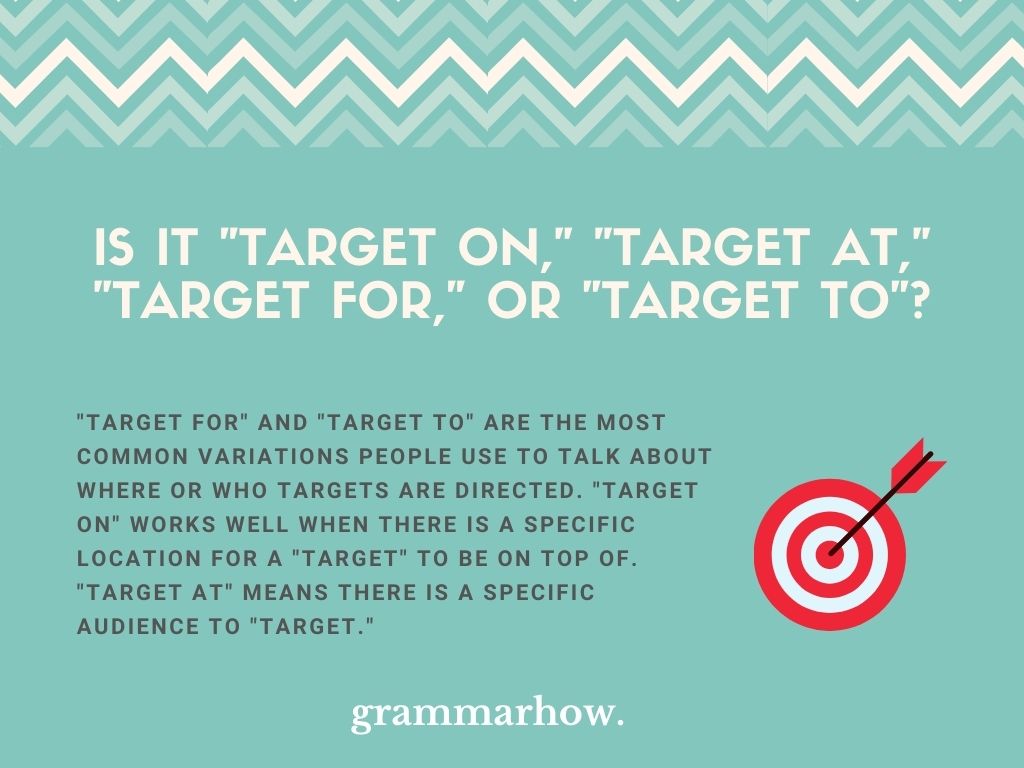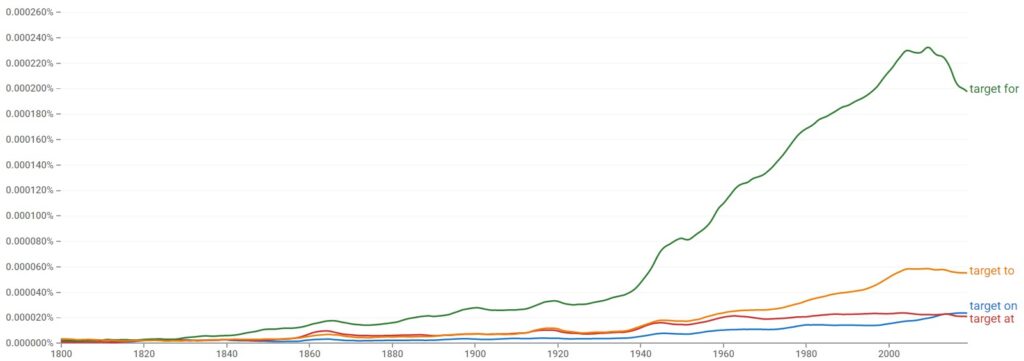A lot of thought must go into using prepositions before you can be confident using them. Different words have different rules, and this article will look at whether we use “on,” “at,” “for,” or “to” when combining the prepositions with “target.”
Is It “Target On,” “Target At,” “Target For,” Or “Target To”?
“Target for” and “target to” are the most common variations people use to talk about where or who targets are directed. “Target on” works well when there is a specific location for a “target” to be on top of. “Target at” means there is a specific audience to “target.”

“Target” is a very versatile verb when it comes to using prepositions. There are plenty of good reasons to use any of the four we’ve discussed.
Sometimes, you might even find that prepositions aren’t necessary. It depends on the type of writing you are conducting. It’s much more likely to use “target” with a preposition when you’re writing in the passive voice:
- This can be targeted at young people.
Should “Target” Be Used Without A Preposition?
Continuing on from before, we typically use “target” without a preposition when writing in the active voice. It’s a much more abrupt way of using the verb, which is fairly common in English.
You do not need to include a preposition when using “target.” “Target” on its own allows us to show that we are talking about a specific target or aim that needs to be completed.
Here are a couple of examples that might help you:
- We should target the younger audience to make sure they’re engaged with it.
- You must target them with this information if you want anything to be done about it.
- Why can’t we target someone who is more effective?
- Let’s not waste our target on something that is subjective.
- I don’t think this target works for what we’re trying to achieve.
As you can see, “target” works as both a verb and a noun, and we do not have to use a preposition after it in either case.
When Should I Use “Target On”?
Sometimes, prepositions are useful to include after the word. Perhaps after you’ve seen some of these examples, you’ll understand more about them:
- There is a target on my back, and I really need to be careful.
- He’s got a target on his head, and people are watching him very closely.
- I have a target on the board, and I want to make sure that I can hit it.
- I have targeted on him because I know that you’ll be able to get the results I strive for.
- There is a large target on him, and I fear that he’s not ready to take on the challenge.
“Target on” isn’t entirely common. We mainly use it to show that someone has a “target” on top of themselves (meaning that someone might be hunting them).
When Should I Use “Target At”?
“Target at” is a bit more of a popular choice, so these examples might make more sense to you.
- This product should be targeted at people who are actually interested in it.
- This is not targeted at you, so I don’t think you should pass any comments about it.
- I want to target it at younger people, but I don’t know how to advertise.
- If you’re going to target it at them, you’ll need to know how they think.
- We should target it at the people who we can trust to enjoy this product.
“Target at” works in more specific circumstances. We mainly use it when we are aiming a product or design toward certain groups of people.
When Should I Use “Target For”?
Next, we’ll see how “target for” makes sense. This can work to give people a goal in their field:
- I have set a target for you to achieve, and I expect you to do it.
- The target for this project is a little out of reach! I don’t think we can do it.
- What is the target for this? I don’t get why you put it so high.
- I can’t figure out the target for this design. It doesn’t make any sense to me.
- I’m sure the target for all these things is irrelevant.
“Target for” usually refers to someone or something that we are aiming at. It might also give people a deadline or goal to try and achieve and treat it as a “target.”
When Should I Use “Target To”?
Finally, let’s see how “target to” works:
- I have set a target to achieve, and I expect you to do it.
- The target towards this project is set in stone now.
- You have many targets to attend to.
- I think the target to focus on is a lot more important than you realize.
- If I targeted towards people who mattered, I wouldn’t have this problem.
“Target to” works when we have a specific group of people or an item that we are “targeting.” This allows us to show what the audience is supposed to be.
Is “Target On,” “Target At,” “Target For,” Or “Target To” Used The Most?
It might help if you saw some statistics to show you which is more common. From the examples above, you might already be able to work out which ones are more popular (based on contextual usage).
According to Google Ngram Viewer, “target for” is the most popular choice by a long way. That’s because it’s versatile and can be used as both a verb and a noun when we need to.

“Target to” is the next most popular, but “at” and “for” don’t seem to get all that much usage.
Which Other Prepositions Can Be Used After “Target”?
The only real prepositions we can use after “target” are the ones we’ve already spoken about. However, we can extend “to” if we want to.
You can use “toward” as another preposition, though it works in much the same way as “to.” Both of them talk about setting a target “toward” a group of people or a person.

Martin holds a Master’s degree in Finance and International Business. He has six years of experience in professional communication with clients, executives, and colleagues. Furthermore, he has teaching experience from Aarhus University. Martin has been featured as an expert in communication and teaching on Forbes and Shopify. Read more about Martin here.

